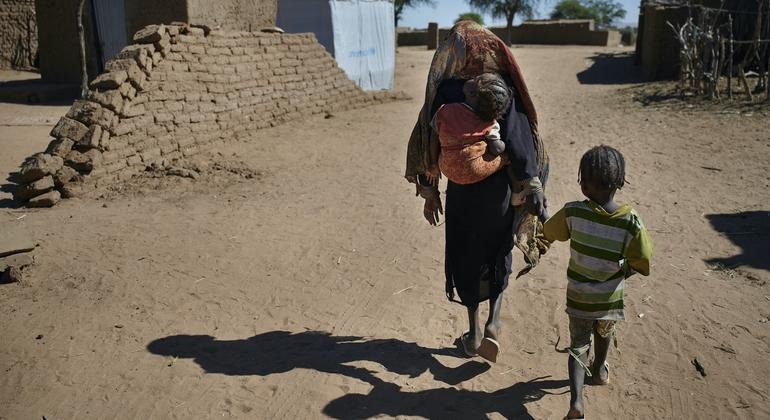
Zamzam Camp: Renewed Killings, Endless Displacement, and Untold Suffering
North Darfur, (Sudan Bukra) - It is as if fate has condemned them to perpetual flight, uprooting, and a life of misery and fear. For decades, Zamzam Camp—located 15 kilometers south of El Fasher—had been a refuge for hundreds of thousands fleeing the conflict in Darfur. Once considered a place of safety, it has now turned into the site of yet another humanitarian catastrophe. After an assault by the Rapid Support Forces (RSF) and their takeover of the camp, residents were subjected to horrific abuses, while international silence prevailed. The camp has since disappeared from the map of aid and relief operations, leaving behind thousands of untold stories of suffering.
A “city” in the desert
Established in 2004, Zamzam became one of Sudan’s largest displacement camps. Before the outbreak of renewed war in 2023, it sheltered more than 120,000 displaced people. By early 2024, that figure had swelled to between 500,000 and 700,000—mostly women, children, and the elderly. The camp had grown into a miniature city, with markets, health facilities, and schools supported by international and local aid groups.
But by February and March 2025, the picture changed dramatically. Rising attacks on Zamzam and nearby areas forced Médecins Sans Frontières (MSF) to suspend its activities, including the camp’s field hospital. The most devastating assault came between April 11 and 13, 2025, lasting three days and leaving more than 400 people dead and around 400,000 residents fleeing in panic. Reports say attackers looted and burned homes and shops, turning the once-bustling camp into a lifeless ruin.
Voices from the catastrophe
Displaced people describe how their lives have deteriorated. Unlike in the early days of the war—when food and shelter were still available—today there is no security, no tents, and no food.
“I never thought we would one day be forced to leave everything behind,” recalls 65-year-old Mohammed Yousif, who fled Zamzam for Tawila. “I saw people shot at random… we ran without knowing where to go. I have been displaced before, but never like this. At least in the past we had food and tents. Now we sleep under trees and eat whatever we find. No one cares about us.”
In El Fasher, Fatima Ali, who escaped with her three children, describes her struggle: “In the camp I used to sell tea to feed my kids. Now I can’t even leave the house for fear of being killed or raped. We have no money, no food—my children cry from hunger and I have nothing to give them.”
Claire Nicolet, MSF’s Deputy Head of Emergencies, told The Guardian that the assault targeted “one of the most vulnerable populations on Earth.” Survivors, she said, faced “widespread looting, sexual violence, and other attacks along the way, in addition to horrific living conditions in makeshift displacement sites.”
Women targeted
For women, the ordeal has been especially brutal. “Amina” recounted being raped by armed men while attempting to return home after the fall of the camp. According to her, attackers deliberately selected young girls while letting older women go—a practice she described as “horrific.”
Fatima, another survivor, now suffers from acute psychological trauma. “There is no protection. Women are left defenseless and become easy targets,” she said.
The Guardian also reported that many women had been abducted, with more than 20 taken to Nyala—RSF’s stronghold 160 kilometers from Zamzam—and still unaccounted for.
Numbers that shame silence
Figures from humanitarian groups paint a grim picture. According to the SIHA Network, by April 13 at least 330 civilians had been documented killed, including 42 women, along with 200 women injured and a number of children. The true toll is believed to be far higher.
A UN report shows that food insecurity in the camp had already reached critical levels, with nearly half of residents going hungry before the attack. With survivors now scattered across areas with no aid, the crisis is expected to deepen further.
The reports also warn that more than 825,000 children across the region are at extreme risk due to displacement, malnutrition, and the collapse of health and education services. An entire generation faces destruction.
Aid efforts collapse amid urgent needs
Humanitarian organizations had been working tirelessly in Zamzam, but after the attack their operations ceased, cutting off contact with thousands of displaced families.
“We were providing food and healthcare to hundreds of thousands. Now we don’t know their fate,” said one aid worker. “We fear the catastrophe we had long warned about has already happened.”
The worker stressed that urgent international action is now needed to open safe corridors for displaced people, deliver aid to new areas of flight, and pressure warring parties to protect civilians.
- This report is published by the Sudan Media Forum and its member organizations, prepared by (Sudan Bukra), to shed light on the plight of Zamzam—once Sudan’s largest displacement camp—now devastated by violence and neglect. In the absence of media coverage and international response, the suffering of hundreds of thousands continues to deepen, demanding urgent action to prevent yet another humanitarian disaster.


